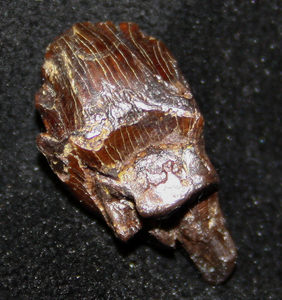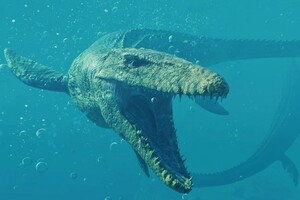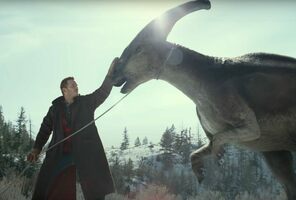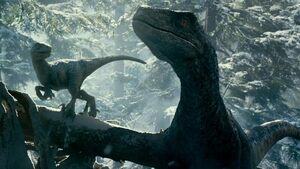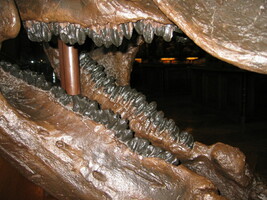About Dinosaur Teeth
Nothing can be quite as menacing as the deadly grin of a Tyrannosaurus. Though scary, those massive teeth served a very integral purpose to the life of the dinosaur. By looking at the size, shape, curvature, wear, and numerous other details of teeth, scientists can discern not just what the dinosaur ate, but also intricacies on how it ate, and how it fit in with the other animals and plants in its ecosystem.

Left to Right: Carcharodontosaurus (slicing flesh), Spinosaurus (catching fish), Ankylosaurus (sniping vegetation), Triceratops (grinding vegetation)
Most dinosaurs replace their teeth very rapidly, with some adults going through thousands of teeth in their lifetimes. This process is continuous and as the crowns are shed other teeth take their place and the root of the tooth is absorbed. Because of this dissociated dinosaur teeth without crowns are quite common in the fossil record. Rooted teeth are much rarer, the root of a tooth is quite fragile and the tooth would have to come from an animal’s skull after death has already occurred. Unerupted teeth are occasionally found as well. These teeth never passed through the gum tissues while the animal was alive so they show no feeding wear.
Typically teeth are not found in pristine condition and will show wear from feeding. This wear can give clues as to specifically what the creature ate and how the jaw moved when it was feeding. Each dinosaur species fits into specific dietary niches within their ecosystems. One animal may graze on coarser plants close to the ground while another eats softer vegetation higher up and their teeth will vary based on the differences in their diets.
Because of the specificity of dinosaur diets many species typically have only a single type of tooth in their jaws with variations only in size. The big exception to this is most meat-eating dinosaurs, who’s teeth sometimes varied significantly in size and shape as one moves back in the jaw. The front teeth (premaxilla teeth) were typically much more conical in shape and closely packed making them ideal for gripping and pulling. The teeth further back in the jaw frequently were more blade like to aid in cutting and slicing of meat. This variation in tooth shape sometimes makes it very difficult to assign isolated teeth to a particular dinosaur species.
Tyrannosaurus rex is the reigning king of tooth size with the longest recorded tooth being 12” long. This measurement includes the root of the tooth with the exposed portion being around 6”. The tiniest teeth likely belong to the needle-like teeth of the paravian dinosaurs like Microraptor.
Many theropods lose teeth while digging into their meals and they’ve occasionally been found embedded in the fossilized remains of their prey. Many times fossil teeth are all that are known of a species. This is the case with the elusive Moroccan “raptor”, known only from plentiful teeth found in the desert, yet no skeletal remains have been discovered.
Isolated teeth like these can give hints as to how many different species lived in an area, however fossilization favors ecosystems where water is present and finding only teeth from an animal may be deceiving. Teeth are often small and can tumble downstream in a current much like any stone or pebble. It’s unlikely that skeletal remains will be found from mountain dwelling dinosaurs, but their teeth could flow down the mountain to be deposited in the floodplains far below to mingle with teeth and skeletal remains of dinosaurs that lived in that river environment. This is an extreme example, but it points out how assuming the mountain dinosaur lived on the floodplains based only on tooth remains can be problematic.
Carinae - The ridges that typically form the sharp edges of therapod teeth.
Denticles - The serrations that form on the carinae.
Root - Part of the tooth embedded in the jaw.
Crown - Part of the tooth above the jaw and typically covered with enamel.
Enamel - Hard and shiny outer surface of teeth.
Maxilla - Bones forming the upper jaw that typically contain teeth.
Pre-Maxilla - The bones at the front of the snout that often bear teeth.
Dentary - Bones forming the lower jaw that typically contain teeth.
Pre-Dentary - The bones at the front of the lower jaw. Not often present.
Tyrannosaurus rex had approximately 60 robust serrated teeth that were wide and dull compared to the flat and dagger-like teeth of other carnivorous dinosaurs. These teeth varied in shape and purpose. The front teeth were closely packed, were more chisel-like that the rest, and were for gripping and pulling. Its side teeth were more widely spaced and were for tearing flesh. The curve of the teeth, the reinforcing ridges, and their robustness allowed the teeth to withstand forces that could be exerted by taking down live prey solely with its mouth. Even with teeth seemingly built for grasping struggling prey, the debate continues as to whether Tyrannosaurus was a hunter or a scavenger. View Tyrannosaurus Teeth For Sale...
Spinosaurus had a skull with a narrow snout filled with approximately 64 straight conical teeth with two carinae that lacked serrations. The hypothesis is that Spinosaurus was a semi-aquatic piscivore, meaning that it ate fish. The teeth had an interesting arrangement with 12-14 teeth in the pre-maxilla that were slightly curved with the 2nd and 3rd of these teeth being much larger than those around them. Teeth from the lower jaw fit into the gaps created by this space. Small Spinosaurus teeth from 1-3 inches long are surprisingly common in the Kem Kem Beds of Morocco, but including the roots they could probably reach about 8-10 inches long. View Spinosaurus Teeth For Sale...
Triceratops teeth are very common fossils and there is a reason for it. Their teeth grew in 36 to 40 columns in each section of the jaw. Each column contained 3-5 stacked teeth that displaced the one above it. As the teeth became worn flat from the vertical shearing method they used to process large volumes of fibrous vegetation, they would shed the tooth and replace it with the already formed tooth underneath it. These shed teeth are often referred to as “spitters” and this tooth replacement was continuous and occurred throughout the life of the animal. Only a fraction of the 432-800 teeth that were held in their tooth batteries were in use at one time. A truly unique feature of Ceratopsia teeth are their two-pronged roots that interlocked with the underlying teeth. View Triceratops Teeth For Sale...
Diplodocus had approximately 40 small, peg-like teeth located bunched together in the front section of its jaw. It replaced these long and slender teeth at a rate of one tooth every 35 days. The apex of the tooth forms a rounded off triangle that rounds out even more as it approaches the root. Diplodocus had an elongated skull which likely helped strip the foliage off of longer sections of branches in one single action. This method of feeding created unusual wear patterns on its teeth with the teeth being worn down on the tips and on the edges facing the cheeks. View Sauropod Dinosaur Teeth For Sale...
Camarasaurus had around 54-56 teeth with the longest being 7.5” tall including the roo). The teeth were chisel or spoon shaped and arranged evenly along the jaw. The strength of the teeth indicates that Camarasaurus probably ate coarser plant material than the Diplodocus and this is indicated in the structure of its skull and the muscular of the jaw which allowed for high biting forces. Despite this added strength Camarasaurus still had an average tooth replacement rate at about one tooth every 62 days. View Camarasaurus Teeth For Sale...
The jaws of Allosaurus contained approximately 64 serrated teeth that become progressively smaller as they approach the back of the mouth. If you compare an Allosaurus skull to that of a Tyrannosaurus you will notice that the teeth are proportionally smaller in Allosaurus. The neck and jaws of Allosaurus show adaptations that suggest an interesting hunting method. They could open their jaws very wide and possibly use the short teeth in their jaws like that teeth of a saw blade and take out chunks of flesh by using slashing motions with its entire head. In this way they could graze on chunks of flesh, letting the prey survive another day to be “harvested” again, or they could weaken the victim slowly until they could be taken down. Their teeth like most other therapods were shed easily, and were replaced continually, making them relatively common fossils. Most Allosaurus teeth average around an inch (not including the root), and anything over 2 inches is considered quite large.View Allosaurus Teeth For Sale...
Edmontosaurus had dental batteries much like that of Triceratops and their teeth were continually replaced. Edmontosaurus had 48-53 columns depending on the size and age of the individual. Their teeth had diamond shaped crowns and have been found with up to 6 stacked teeth per column and took around 6 months to form. How Edmontosaurus processed its food is still under debate, the contention coming mainly on the motion of the jaw and whether the teeth were used in a forward to backward motion like rasps, and up and don motion with flexion of the lower jaw bones allowing a sliding and shearing action, or instead a combination that would create a more oblique motion. There teeth were quite small with the crowns often being about 1/2 inch long.View Edmontosaurus Teeth For Sale...
Carcharodontosaurus was originally only know from a couple of teeth that were lost in the same WWII bombing that destroyed the remains of Spinosaurus. Newer discoveries have been found of this Cretaceous carnivore that have shed more light as to how it lived. Carcharodontosaurus had enormous jaws that contained approximately 64 long, blade-like and very sharp serrated teeth up to eight inches long. It had one of the largest skulls and was equal to, and often larger than that of Tyrannosaurus. The teeth are relatively narrow, curve slightly back and have slight enamel wrinkles that spread out from the carinae. It was a contemporary of Spinosaurus and because of the completely different tooth structure its obvious these massive predators dined on different prey. View Carcharodontosaurus Teeth For Sale...
Smaller theropods like Velociraptor typically did not use their teeth for killing and so their teeth were much smaller in size in relation to their skulls when compared to larger therapods that used their teeth as the primary killing tool. Velociraptor is of course the most well know of the family of Dromaeosauridae dinosaurs. Their jaws contained 26-28 blade-like teeth with .4” tall crowns that were widely spaced and contained stronger serrations on the rear facing carinae. Deinonychus was a larger member of the Dromaeosauridae and had seventy curved, blade-like teeth that were around .5” tall but had serrations that were equal in size on the front and rear of the tooth. The elusive “raptor” from Morocco has teeth that range in size from.5-.8” and also have strong rear facing serrations indicating that it was was probably velociraptorine in body structure. With skeletal remains yet to be discovered it’s hard to estimate the size, or know the amount of teeth in its jaws. However the relative sizes of its teeth are similar to that of Deinonychus which reached lengths of around 11ft. View Raptor Teeth For Sale...
Ankylosaurus was herbivorous and had approximately 72 small, leaf-shaped teeth. The teeth were thin and made up of a series of cusps that looked like large serrations and a swollen base or cingulum. It’s likely that the teeth were used to crop vegetation consisting of ferns, cycads, and angiosperms with very little chewing. Along with stegosaurs and pachycephalosaurs, ankylosaurs had the simplest and most primitive tooth morphology of ornithischian dinosaurs. View Ankylosaurus Teeth For Sale...
Stegosaurus was a herbivorous dinosaur with around 78 small, triangular and flat teeth that it use to consume a likely diet of plants such as mosses, ferns, horsetails, cycads, and conifers or fruits. The wear that occurs on their teeth show that stegosaurus could grind its food, however the specific way in which it did process its food is still under study. Stegosaurus teeth were not pressed together like most herbivores and therefore did not make an efficient grinding surface and it appeared that it could only move its jaw in an up and down motion and had no side to side movement like a cow.

Left to Right: Carcharodontosaurus (slicing flesh), Spinosaurus (catching fish), Ankylosaurus (sniping vegetation), Triceratops (grinding vegetation)
Most dinosaurs replace their teeth very rapidly, with some adults going through thousands of teeth in their lifetimes. This process is continuous and as the crowns are shed other teeth take their place and the root of the tooth is absorbed. Because of this dissociated dinosaur teeth without crowns are quite common in the fossil record. Rooted teeth are much rarer, the root of a tooth is quite fragile and the tooth would have to come from an animal’s skull after death has already occurred. Unerupted teeth are occasionally found as well. These teeth never passed through the gum tissues while the animal was alive so they show no feeding wear.
Typically teeth are not found in pristine condition and will show wear from feeding. This wear can give clues as to specifically what the creature ate and how the jaw moved when it was feeding. Each dinosaur species fits into specific dietary niches within their ecosystems. One animal may graze on coarser plants close to the ground while another eats softer vegetation higher up and their teeth will vary based on the differences in their diets.
Because of the specificity of dinosaur diets many species typically have only a single type of tooth in their jaws with variations only in size. The big exception to this is most meat-eating dinosaurs, who’s teeth sometimes varied significantly in size and shape as one moves back in the jaw. The front teeth (premaxilla teeth) were typically much more conical in shape and closely packed making them ideal for gripping and pulling. The teeth further back in the jaw frequently were more blade like to aid in cutting and slicing of meat. This variation in tooth shape sometimes makes it very difficult to assign isolated teeth to a particular dinosaur species.
Tyrannosaurus rex is the reigning king of tooth size with the longest recorded tooth being 12” long. This measurement includes the root of the tooth with the exposed portion being around 6”. The tiniest teeth likely belong to the needle-like teeth of the paravian dinosaurs like Microraptor.
Many theropods lose teeth while digging into their meals and they’ve occasionally been found embedded in the fossilized remains of their prey. Many times fossil teeth are all that are known of a species. This is the case with the elusive Moroccan “raptor”, known only from plentiful teeth found in the desert, yet no skeletal remains have been discovered.
Isolated teeth like these can give hints as to how many different species lived in an area, however fossilization favors ecosystems where water is present and finding only teeth from an animal may be deceiving. Teeth are often small and can tumble downstream in a current much like any stone or pebble. It’s unlikely that skeletal remains will be found from mountain dwelling dinosaurs, but their teeth could flow down the mountain to be deposited in the floodplains far below to mingle with teeth and skeletal remains of dinosaurs that lived in that river environment. This is an extreme example, but it points out how assuming the mountain dinosaur lived on the floodplains based only on tooth remains can be problematic.
Glossary of Dental Terminology
Carinae - The ridges that typically form the sharp edges of therapod teeth.
Denticles - The serrations that form on the carinae.
Root - Part of the tooth embedded in the jaw.
Crown - Part of the tooth above the jaw and typically covered with enamel.
Enamel - Hard and shiny outer surface of teeth.
Maxilla - Bones forming the upper jaw that typically contain teeth.
Pre-Maxilla - The bones at the front of the snout that often bear teeth.
Dentary - Bones forming the lower jaw that typically contain teeth.
Pre-Dentary - The bones at the front of the lower jaw. Not often present.
Common Dinosaurs and Their Teeth
Tyrannosaurus
Tyrannosaurus rex had approximately 60 robust serrated teeth that were wide and dull compared to the flat and dagger-like teeth of other carnivorous dinosaurs. These teeth varied in shape and purpose. The front teeth were closely packed, were more chisel-like that the rest, and were for gripping and pulling. Its side teeth were more widely spaced and were for tearing flesh. The curve of the teeth, the reinforcing ridges, and their robustness allowed the teeth to withstand forces that could be exerted by taking down live prey solely with its mouth. Even with teeth seemingly built for grasping struggling prey, the debate continues as to whether Tyrannosaurus was a hunter or a scavenger. View Tyrannosaurus Teeth For Sale...
Spinosaurus
Spinosaurus had a skull with a narrow snout filled with approximately 64 straight conical teeth with two carinae that lacked serrations. The hypothesis is that Spinosaurus was a semi-aquatic piscivore, meaning that it ate fish. The teeth had an interesting arrangement with 12-14 teeth in the pre-maxilla that were slightly curved with the 2nd and 3rd of these teeth being much larger than those around them. Teeth from the lower jaw fit into the gaps created by this space. Small Spinosaurus teeth from 1-3 inches long are surprisingly common in the Kem Kem Beds of Morocco, but including the roots they could probably reach about 8-10 inches long. View Spinosaurus Teeth For Sale...
Triceratops
Triceratops teeth are very common fossils and there is a reason for it. Their teeth grew in 36 to 40 columns in each section of the jaw. Each column contained 3-5 stacked teeth that displaced the one above it. As the teeth became worn flat from the vertical shearing method they used to process large volumes of fibrous vegetation, they would shed the tooth and replace it with the already formed tooth underneath it. These shed teeth are often referred to as “spitters” and this tooth replacement was continuous and occurred throughout the life of the animal. Only a fraction of the 432-800 teeth that were held in their tooth batteries were in use at one time. A truly unique feature of Ceratopsia teeth are their two-pronged roots that interlocked with the underlying teeth. View Triceratops Teeth For Sale...
Diplodocus
Diplodocus had approximately 40 small, peg-like teeth located bunched together in the front section of its jaw. It replaced these long and slender teeth at a rate of one tooth every 35 days. The apex of the tooth forms a rounded off triangle that rounds out even more as it approaches the root. Diplodocus had an elongated skull which likely helped strip the foliage off of longer sections of branches in one single action. This method of feeding created unusual wear patterns on its teeth with the teeth being worn down on the tips and on the edges facing the cheeks. View Sauropod Dinosaur Teeth For Sale...
Camarasaurus
Camarasaurus had around 54-56 teeth with the longest being 7.5” tall including the roo). The teeth were chisel or spoon shaped and arranged evenly along the jaw. The strength of the teeth indicates that Camarasaurus probably ate coarser plant material than the Diplodocus and this is indicated in the structure of its skull and the muscular of the jaw which allowed for high biting forces. Despite this added strength Camarasaurus still had an average tooth replacement rate at about one tooth every 62 days. View Camarasaurus Teeth For Sale...
Allosaurus
The jaws of Allosaurus contained approximately 64 serrated teeth that become progressively smaller as they approach the back of the mouth. If you compare an Allosaurus skull to that of a Tyrannosaurus you will notice that the teeth are proportionally smaller in Allosaurus. The neck and jaws of Allosaurus show adaptations that suggest an interesting hunting method. They could open their jaws very wide and possibly use the short teeth in their jaws like that teeth of a saw blade and take out chunks of flesh by using slashing motions with its entire head. In this way they could graze on chunks of flesh, letting the prey survive another day to be “harvested” again, or they could weaken the victim slowly until they could be taken down. Their teeth like most other therapods were shed easily, and were replaced continually, making them relatively common fossils. Most Allosaurus teeth average around an inch (not including the root), and anything over 2 inches is considered quite large.View Allosaurus Teeth For Sale...
Edmontosaurus
Edmontosaurus had dental batteries much like that of Triceratops and their teeth were continually replaced. Edmontosaurus had 48-53 columns depending on the size and age of the individual. Their teeth had diamond shaped crowns and have been found with up to 6 stacked teeth per column and took around 6 months to form. How Edmontosaurus processed its food is still under debate, the contention coming mainly on the motion of the jaw and whether the teeth were used in a forward to backward motion like rasps, and up and don motion with flexion of the lower jaw bones allowing a sliding and shearing action, or instead a combination that would create a more oblique motion. There teeth were quite small with the crowns often being about 1/2 inch long.View Edmontosaurus Teeth For Sale...
Carcharodontosaurus
Carcharodontosaurus was originally only know from a couple of teeth that were lost in the same WWII bombing that destroyed the remains of Spinosaurus. Newer discoveries have been found of this Cretaceous carnivore that have shed more light as to how it lived. Carcharodontosaurus had enormous jaws that contained approximately 64 long, blade-like and very sharp serrated teeth up to eight inches long. It had one of the largest skulls and was equal to, and often larger than that of Tyrannosaurus. The teeth are relatively narrow, curve slightly back and have slight enamel wrinkles that spread out from the carinae. It was a contemporary of Spinosaurus and because of the completely different tooth structure its obvious these massive predators dined on different prey. View Carcharodontosaurus Teeth For Sale...
Velociraptor
Smaller theropods like Velociraptor typically did not use their teeth for killing and so their teeth were much smaller in size in relation to their skulls when compared to larger therapods that used their teeth as the primary killing tool. Velociraptor is of course the most well know of the family of Dromaeosauridae dinosaurs. Their jaws contained 26-28 blade-like teeth with .4” tall crowns that were widely spaced and contained stronger serrations on the rear facing carinae. Deinonychus was a larger member of the Dromaeosauridae and had seventy curved, blade-like teeth that were around .5” tall but had serrations that were equal in size on the front and rear of the tooth. The elusive “raptor” from Morocco has teeth that range in size from.5-.8” and also have strong rear facing serrations indicating that it was was probably velociraptorine in body structure. With skeletal remains yet to be discovered it’s hard to estimate the size, or know the amount of teeth in its jaws. However the relative sizes of its teeth are similar to that of Deinonychus which reached lengths of around 11ft. View Raptor Teeth For Sale...
Ankylosaurus
Ankylosaurus was herbivorous and had approximately 72 small, leaf-shaped teeth. The teeth were thin and made up of a series of cusps that looked like large serrations and a swollen base or cingulum. It’s likely that the teeth were used to crop vegetation consisting of ferns, cycads, and angiosperms with very little chewing. Along with stegosaurs and pachycephalosaurs, ankylosaurs had the simplest and most primitive tooth morphology of ornithischian dinosaurs. View Ankylosaurus Teeth For Sale...
Stegosaurus
Stegosaurus was a herbivorous dinosaur with around 78 small, triangular and flat teeth that it use to consume a likely diet of plants such as mosses, ferns, horsetails, cycads, and conifers or fruits. The wear that occurs on their teeth show that stegosaurus could grind its food, however the specific way in which it did process its food is still under study. Stegosaurus teeth were not pressed together like most herbivores and therefore did not make an efficient grinding surface and it appeared that it could only move its jaw in an up and down motion and had no side to side movement like a cow.
 Reviews
Reviews

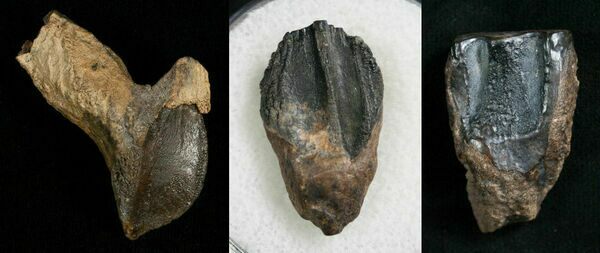

.jpg)
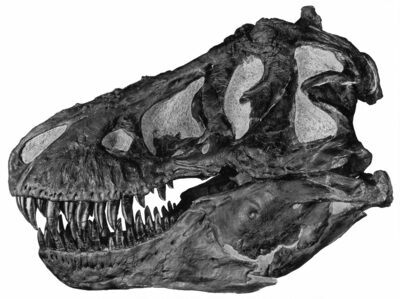

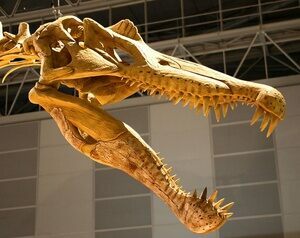
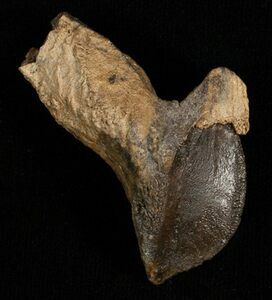
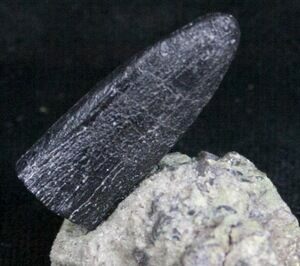
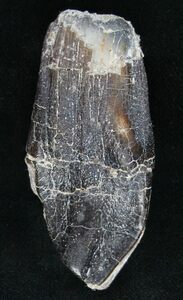
.jpg)
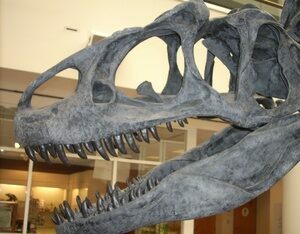
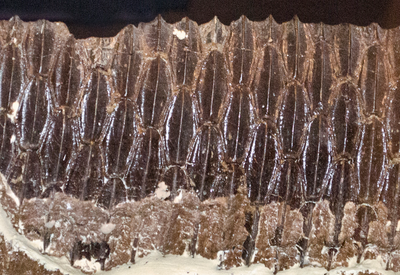
.jpg)

